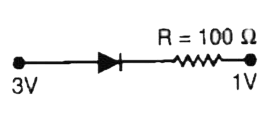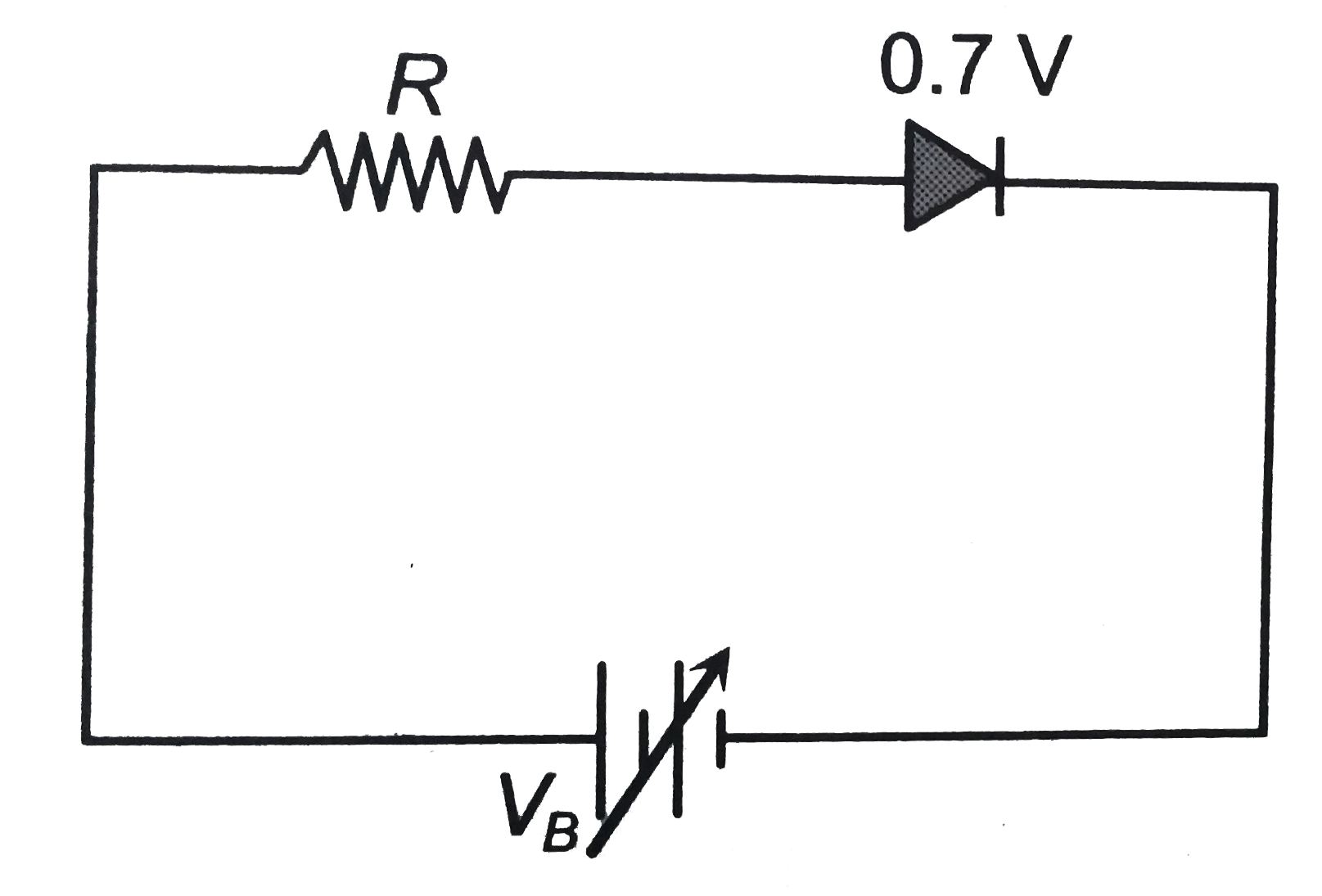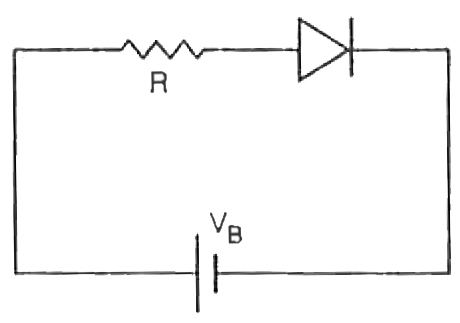Assuming that the silicon diode having resistance of 20Ω , the current through the diode is (knee voltage 0.7 V) :
 Solution in Kannada
Solution in Kannada
0 mA
10 mA
6.5 mA
13.5 mA
The correct Answer is:C
i=VF−VBR=2−0.720+180=1.3200
⇒i=6.5×10−3=6.5 mA
Topper's Solved these Questions
- BOOK - MODERN PUBLICATIONCHAPTER - SOLIDS & SEMICONDUCTOR DEVICESEXERCISE - Multiple Choice Questions - LEVEL -I (ASSERTION)5videos
SOLIDS & SEMICONDUCTOR DEVICES
- BOOK - MODERN PUBLICATIONCHAPTER - SOLIDS & SEMICONDUCTOR DEVICESEXERCISE - Multiple Choice Questions - LEVEL -I (PARAGRAPH)6videos
SOLIDS & SEMICONDUCTOR DEVICES
- BOOK - MODERN PUBLICATIONCHAPTER - ROTATIONAL MOTIONEXERCISE - RCQ8videos
ROTATIONAL MOTION
- BOOK - MODERN PUBLICATIONCHAPTER - TRANSFERENCE OF HEAT EXERCISE - Recent Competitive Questions4videos
TRANSFERENCE OF HEAT
Similar Questions
Statement I : In N - type semiconductor , the free electron concentration approximately equals the density of donor atoms .
Statement II : In a forward biased P - N - region is proportional to the change Q of the injected minority carrier holes.02:57View SolutionIn a triode value for a grid voltage Vg=−1.2V , the phase current Ip and plate voltage Vp are given Ip=(−5+0.1V0),Ip in mAandVp in volt . When grid voltage is changed to - 3.2 V at constant plate voltage of 150 V , a plate current of 5 mA is observed , then
Plate resistance Rp is02:57View SolutionThe moment of inertia of a circular disc of radius 2 m and mass 1 kg about an axis passing through the centre of mass but perpendicular to the plane of the disc is 2 kg m2. Its moment of inertia about an axis parallel to this axis but passing through the edge of the disc is :
 03:11View Solution
03:11View SolutionTwo slabs are of the thicknesses d1 and d2. Their thermal conductivities are K1 and K2 respectively They are in series. The free ends of the combination of these two slabs are kept at temperatures θ1 and θ2. Assume θ1>θ2. The temperature θ of their common junction is
02:03View SolutionThe junction diode in the following circuit requires a minimum current of 1mA to be above the knee point (0.7V) of its I−V characterstic curve. The voltage across the diode is independent of current above the knee point. If VB=5V, then the maximum value of R so that the voltage is above the knee point, will be
 03:34View Solution
03:34View SolutionAssume that silicon diode in the circuit Fig. requires minimum current of 1 mA to be above the knee point (0.7 V) of its I-V characteristics. Also assume that the voltage across the diode is independent of current above the knee point. If V_(B)=5V , what should be the minimum value of R so that the voltage is above the knee point? If V_(B)=5V , what should be the value of R to establish the current of 5mA in the circuit? What is the power dissipated in the resistance R and in the diode, when a current of 5mA flows in the circuit at V_(B)=6V . If R=1kOmega , what is the minimum voltage V_(B) required to keep the diode above the knee point?
04:39View SolutionA silicon p-n junction diode whose knee voltage is 0.7V is connected to a battery with supply voltage 3V and 100mA in forward biasing. If a resistor R is used in series of the circuit, then a current of 20mA passes through the diode. Find the wattage of the resistor and of the diode.
02:42View SolutionAssuming that the silicon diode having resistance of 20 Omega , the current through the diode is (knee voltage 0.7 V)
04:17View SolutionAssume that the silicon diode in the given circuit requires a minimum current of 1 mA to be above the (knee-point voltage = 0.7 V) of its I−V characteristics. Assuming that the voltage across the diode is independent of current above the knee-point, find the maximum value of R so that the voltage is above the knee-point if VB=5A. Also find the value of R to establish a current of 5 mA in the circuit for the since voltage.
 02:03View Solution
02:03View SolutionDraw the circuit to forward bias a diode. (The supply is 3V and 100mA battery). If the diode is made of silicon and knee voltage is 0.7V, and a current of 20mA passes through the diode, find the wattge of the resistor and the diode.
04:06View SolutionAssuming that the silicon diode (having negligible resistance) the current through the diode is (knee voltage of silicon diode is 0.7V )
03:50View SolutionAn a.c. voltage of peak value 20 V is connected in series with a silicon diode and a load resistance of 500 G. The forward resistance of the diode is 10 G and the barrier voltage is 0.7 V. Find the peak current through diode and the peak voltage across the load.
02:56View Solutionसिलिकॉन डायोड के निम्न प्रेक्षणों से डायोड प्रतिरोध की गणना कीजिए
V = 0.8 V पर I= 20 mA तथा V = 0.7 V पर I = 10 mA.03:07View Solution(a) अग्र अभिनत डायोड के लिए परिपथ बनाइए जिसमे अभिनति वोलटता 3.0 V, 100 mA की बैटरी से दी जाती है|
(b) यदि डायोड सिलिकॉन का बना हो एवं नी -वोलटता (knee voltage) 0.7 V हो एवं 20 mA की धारा डायोड से बहती हो तथा इसके साथ श्रेणीक्रम में एक प्रतिरोध जोड़ा गया हो तो डायोड एवं प्रतिरोध की शक्ति ज्ञात किजीए|View SolutionThe source voltage is 9 volt and source resistance is 1kOmega The current through the silicon diode is (knee voltage of silicon is 0.7 volt):
02:26View Solution

